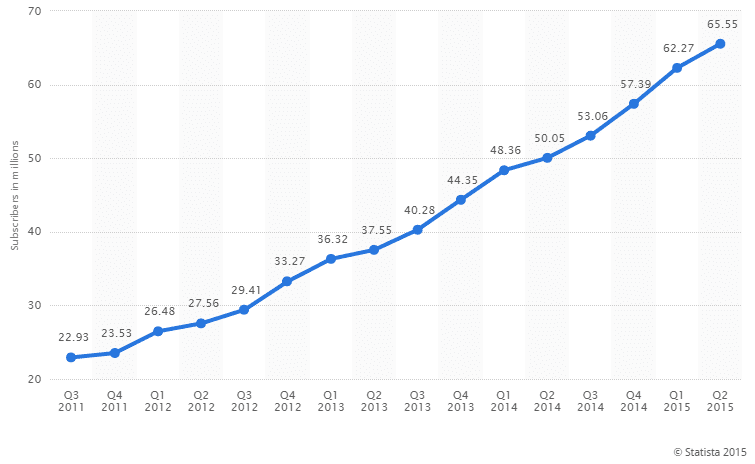The Netflix Effect: Video Streaming’s Effect on Productivity

In an attempt to boost my own personal productivity, I have committed to do the unthinkable for (at least) 3 weeks: cut the cord on Netflix. The popular online television and movie streaming service is now a major player in the entertainment industry, with over $5 billion in annual revenues, and over 65 million subscribers worldwide as of 2nd Quarter 2015.

The popularity of Netflix can be summarized in many ways, but the following statistics aggregated by marketing resource DMR are more than adequate:
- Users watch 10 billion hours of content monthly on Netflix, or 120 billion annually
- 61% of Netflix users binge-watch shows through the service at least every few weeks
- 51% of U.S. millennials use Netflix
- 63% of subscribers are either “very satisfied” or “extremely satisfied” with the service
- 35% of all U.S. & Canadian broadband traffic is consumed by Netflix viewership
These numbers are all testaments to how successful a business Netflix is running, but there is a very real cost in terms of productivity to Netflix viewers when you take into account the following shocking statistic: “The average amount of Netflix content watched per-day, per-subscriber, is 93 minutes.”
This means that, on average, Netflix users (such as myself) view 565.75 hours of Netflix content annually, or 23.57 days.
This number is hardly believable; nearly a month of an average Netflix viewer’s year is spent being passively entertained, or 6.3% of our time every year. These statistics line up closely with my own personal estimate for my viewership statistics; I estimate that I spend between 10-15 hours per-week watching Netflix (or playing video games), for 520-780 hours per-year, and 21.6 days – 32.5 days per-year.
The Compounding Decay of Productivity Potential
As an activity, passive entertainment is hardly new; we have been hearing for years about how the average North American will spend nearly a decade of our lives watching television.
Let’s really think about this; approximately 10 years out of our average 81.24 years life expectancy in Canada, or 12.3% of our lives overall, is spent accomplishing absolutely nothing due to television watching in its various forms. Considering that, based on 8 hours per-night of sleep, we will spend an average of 27 years of our lives sleeping, 45.6% of our lives are being spent in these 2 passive activities on average. Once we factor in that we will work 2,080 hours annually for approximately 45 years (10.65 years of our lives), 41% of our lives remains for just… living life. On top of that, you must remember that some of the remaining would have been spent as an infant (lost memories), and some will be potentially spent dealing with various health issues in old-age.
“Orange is the New Black” is Imprisoning our Growth Potential
If we examine what an average person wants to accomplish in life, it is clear that this amount of television viewership on average is going to hinder our ability to accomplish things such as:
- Achieving early financial freedom/retirement
- Raising well-adjusted children with a high potential for social or career success
- Achieving career milestones
- Making friends and influencing people
- Achievement of milestones in higher education (who doesn’t want to be called Doctor Your Name?
- Completing various journeys of self-discovery
- Discovering higher levels of meaning in life
- Getting into great physical shape
It is clear that spending 10 years of our lives passively entertaining our brains is the easiest area in which personal productivity gains can be found. Netflix will not help us to accomplish major life goals, which are likely more important to us than anything else in life, yet it would appear that Canadians are choosing to use a vast quantity of time on streaming television rather than achieving the things that they want to achieve.
Think about it this way: if we could plan out the rest of our lives by the percentage of our time which we want to spend on certain activities, our list would likely include:
- 33% sleeping (healthy, doctor recommended amount necessary to live a well-balanced lifestyle and accomplish as much as possible)
- 33% working (at most, and only until a nice, early retirement)
- 33% of leisure experiences
This means that non-sleep or work related activities would be spent preparing or eating delicious food, discovering interesting places, having memorable experiences with friends and family, and the like. If you could lock in 6.3% of your lifespan to have memorable experiences with friends and family/achieve an important life goal/ travel to an exotic location/any number of other fulfilling activities, or sit in front of a screen and watch Netflix, which would you commit to? The answer seems clear. Our intentions are to accomplish things important to us, but Netflix makes it too easy and tempting to put these important things on the back burner.
How to Control the Netflix Effect
I know that, unless I do something about my Netflix addiction now, I will be putting accomplishment of important goals on the back burner until it is too late, and I no longer have the time left in my lifespan, or the physical strength to make good on my intentions to achieve important life goals.
Essentially, I want to boost my personal productivity, much in the same way that businesses attempt to boost their production or process productivity. I want to eliminate Netflix, an inefficiency which decreases my overall productivity towards achieving important goals, costing me 6.3% of my time overall, and up to 18% of my overall productive time (waking hours over my lifetime, estimated at 54 years of consciousness based on a life expectancy of 81.24 years, and 27 years spent sleeping). For a business, eliminating an unnecessary bottleneck which slows down the achievement of a business goal by robbing 18% of overall production time is an easy choice. Mentor Works can help businesses to achieve their goals by securing government funding for capital equipment and process enhancement projects to improve overall efficiency. Whether you’re holding the TV remote or leading a business, maximizing productivity is your choice; manage your resources and avoid the temptation to waste your resources on easy activities. Continuous improvement is the key to both a successful life and a successful business.
